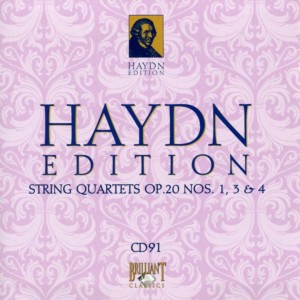Today’s CD picks up where yesterday’s left off, and treats me to the remaining three Op. 20 string quartets – this time, they are:
Haydn String Quartet Op. 20 No. 3 in G Minor
Haydn String Quartet Op. 20 No. 4 in D
Haydn String Quartet Op. 20 No. 1 in E Flat
In the superb Wiki article about Haydn’s Op. 20 string quartets, I discovered,
“This cannot be overstated,” writes Ron Drummond. “The six string quartets of Opus 20 are as important in the history of music, and had as radically a transforming effect on the very field of musical possibility itself, as Beethoven’s Third Symphony would 33 years later.” And Sir Donald Tovey writes of the quartets, “Every page of the six quartets of op. 20 is of historic and aesthetic importance… there is perhaps no single or sextuple opus in the history of instrumental music which has achieved so much.”
Here are some of the innovations of the quartets:
Equality of voices: Prior to opus 20, the first violin, or, sometimes, the two violins, dominated the quartet. The melody was carried by the leader, with the lower voices (viola and cello) accompanying. In opus 20, Haydn gives each instrument, and particularly the cello, its own voice…
Structural innovations: With the opus 20 quartets, Haydn moved forward the development of the Sonata form. A movement written in sonata form has an exposition, where the themes and motifs of the movement are presented, a development section, where these themes are transformed, and a recapitulation, where the themes are restated. Traditionally, the restatement closely matched the original exposition. But Haydn, in opus 20, uses the restatement to further develop the material of the movement…
Depth of expression: Haydn experiments with expressive techniques in the quartets. An example of this is the G minor quartet, number 3, where Haydn defies the standard practice of ending each movement with a cadence played forte. Instead, Haydn ends each movement piano or pianissimo…
Length and symmetry of phrases: Haydn experiments with asymmetrical phrases and syncopations. The common practice of the time was to write melodies that divided neatly into four- and eight-measure chunks. But the opening phrase of the third quartet, in G minor, is seven measures long, and the minuet of the same quartet has a melody that is divided into two phrases of five measures each…
Use of counterpoint: The fugal finales of three of the six quartets are Haydn’s statement of rejection of the galante. Not only has Haydn rejected the freedom of the rococo style, he has emphasized that rejection by adhering to strict formality, and writing comments into the score explaining the fugal structure…
So, Haydn was only 40 years old when he composed these six quartets – which went on to change how string quartets were Continue reading

